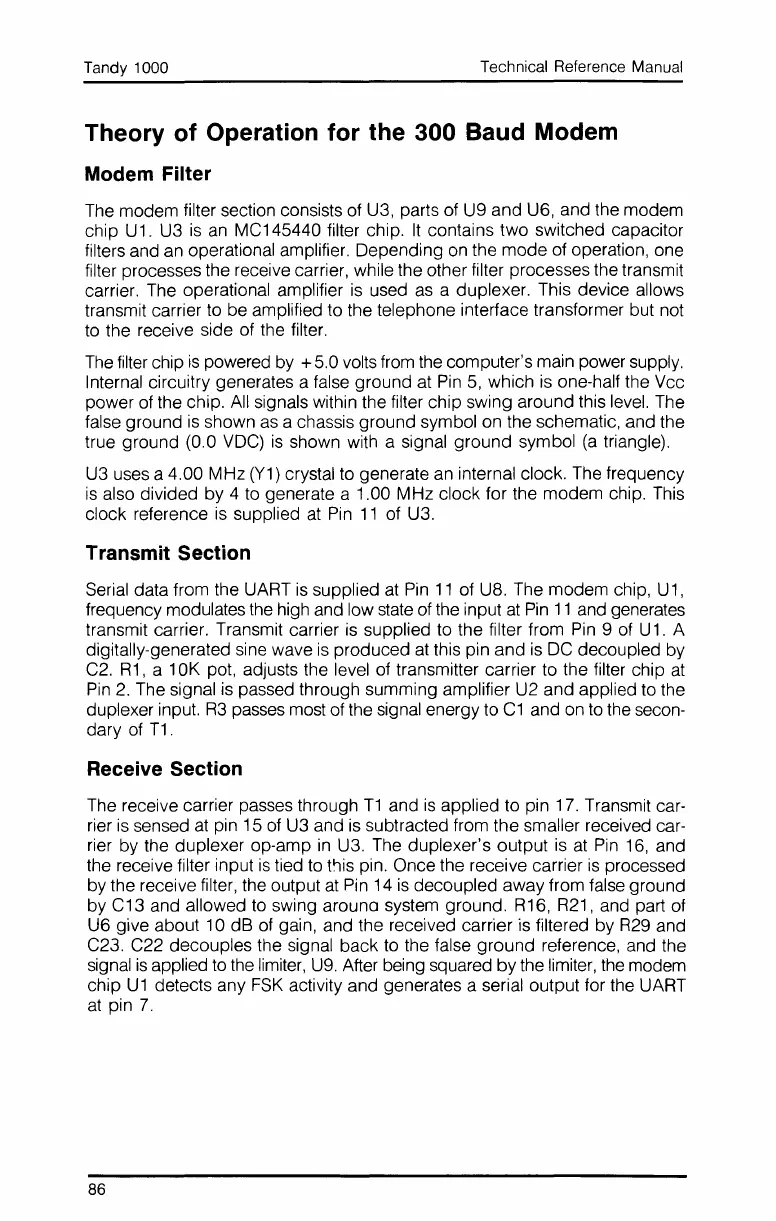Tandy 1000
Technical Reference Manual
Theory of Operation for the 300 Baud Modem
Modem Filter
The modem filter section consists of U3, parts of U9 and U6, and the modem
chip U1. U3
is
an
MC145440 filter chip.
It
contains two switched capacitor
filters and an operational amplifier. Depending on the mode of operation, one
filter processes the receive carrier, while the other filter processes the transmit
carrier. The operational amplifier
is
used
as
a duplexer. This device allows
transmit carrier to be amplified to the telephone interface transformer but not
to the receive side of the filter.
The
filter chip
is
powered by + 5.0 volts from the computer's main power supply.
Internal circuitry generates a false ground at
Pin
5,
which
is
one-half the Vcc
power of the chip.
All
signals within the filter chip swing around this level. The
false ground
is
shown
as
a chassis ground symbol on the schematic, and the
true ground (0.0
VDC)
is
shown with a signal ground symbol
(a
triangle).
U3 uses a 4.00 MHz
(Y1)
crystal to generate an internal clock. The frequency
is
also divided by 4 to generate a 1.00 MHz clock for the modem chip. This
clock reference
is
supplied
at
Pin
11
of U3.
Transmit Section
Serial data from the UART
is
supplied
at
Pin
11
of U8. The modem chip, U
1,
frequency modulates the high and low state of the input
at
Pin
11
and generates
transmit carrier. Transmit carrier
is
supplied to the filter from
Pin
9 of U
1.
A
digitally-generated sine wave
is
produced
at
this pin and
is
DC decoupled by
C2.
R1,
a 10K pot, adjusts the level of transmitter carrier to the filter chip
at
Pin
2.
The signal
is
passed through summing amplifier U2 and applied to the
duplexer input.
R3
passes most of the signal energy to
C1
and on
to
the secon-
dary of
T1.
Receive Section
The receive carrier passes through
T1
and
is
applied to pin 17. Transmit car-
rier
is
sensed
at
pin 15 of U3 and
is
subtracted from the smaller received car-
rier by the duplexer op-amp
in
U3. The duplexer's output
is
at
Pin
16,
and
the receive filter input
is
tied to t1is pin. Once the receive carrier
is
processed
by the receive filter, the output
at
Pin
14
is
decoupled away from false ground
by C13 and allowed to swing arouna system ground. R16, R21, and part of
U6 give about 10 dB of gain, and the received carrier is filtered by
R29
and
C23. C22 decouples the signal back to the false ground reference, and the
signal
is
applied
to
the limiter, U9. After being squared
by
the limiter, the modem
chip
U1
detects any
FSK
activity and generates a serial output for the UART
at
pin
7.
86
